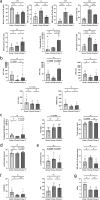B cell subsets in adult-onset Still's disease: potential candidates for disease pathogenesis and immunophenotyping
- PMID: 37322557
- PMCID: PMC10268358
- DOI: 10.1186/s13075-023-03070-2
B cell subsets in adult-onset Still's disease: potential candidates for disease pathogenesis and immunophenotyping
Abstract
Background: Adult-onset Still's disease (AOSD) is a systemic autoinflammatory disorder of unknown etiology. B cells are critical participants in different rheumatic diseases, and their roles in AOSD are rarely investigated. This study aimed to unveil the B cell subset features in AOSD and provide evidence for B cell-based diagnosis and targeted therapies of AOSD.
Methods: B cell subsets in the peripheral blood of AOSD patients and healthy controls (HCs) were detected by flow cytometry. Firstly, the frequencies of B cell subsets were compared. Then, the correlation analysis was performed to explore the correlation between B cell subsets and clinical manifestations in AOSD. Finally, unbiased hierarchical clustering was performed to divide AOSD patients into three groups with different B cell subset features, and the clinical characteristics of the three groups were compared.
Results: The frequencies of B cell subsets were altered in AOSD patients. Disease-promoting subsets (such as naïve B cells, double negative B cells (DN B cells), and plasmablasts) increased, and potential regulatory subsets (such as unswitched memory B cells (UM B cells) and CD24hiCD27+ B cells (B10 cells)) decreased in the peripheral blood of AOSD patients. In addition, the altered B cell subsets in AOSD correlated with the clinical and immunological features, such as immune cells, coagulation features, and liver enzymes. Intriguingly, AOSD patients could be divided into three groups with distinct B cell immunophenotyping: group 1 (naïve B cells-dominant), group 2 (CD27+ memory B cells-dominant), and group 3 (precursors of autoantibody-producing plasma cells-dominant). Moreover, these three group patients demonstrated differential manifestations, including immune cells, liver or myocardial enzymes, coagulation features, and systemic score.
Conclusions: B cell subsets are significantly altered in AOSD patients, potentially contributing to the disease pathogenesis. These findings would inspire B cell-based diagnosis and targeted therapies for this refractory disease.
Keywords: Adult-onset Still’s disease; B cell subsets; Clinical correlation; Immunophenotyping.
© 2023. The Author(s).
Conflict of interest statement
The authors declare no competing interests.
Figures





Similar articles
-
Deep Immunophenotyping of Circulating T and B Cells in Relapsing Adult-Onset Still's Disease.Curr Issues Mol Biol. 2024 Feb 1;46(2):1177-1191. doi: 10.3390/cimb46020075. Curr Issues Mol Biol. 2024. PMID: 38392193 Free PMC article.
-
The Role of RIPK1/3 in Adult Onset Still's Disease Patients With Liver Damage: A Preliminary Study.Front Immunol. 2020 Nov 24;11:560744. doi: 10.3389/fimmu.2020.560744. eCollection 2020. Front Immunol. 2020. PMID: 33329521 Free PMC article.
-
The landscape of innate and adaptive immune cell subsets in patients with adult-onset Still's disease.Rheumatology (Oxford). 2024 Jul 1;63(7):1987-1997. doi: 10.1093/rheumatology/kead507. Rheumatology (Oxford). 2024. PMID: 37756690
-
Adult-onset Still's disease in focus: Clinical manifestations, diagnosis, treatment, and unmet needs in the era of targeted therapies.Semin Arthritis Rheum. 2021 Aug;51(4):858-874. doi: 10.1016/j.semarthrit.2021.06.004. Epub 2021 Jun 13. Semin Arthritis Rheum. 2021. PMID: 34175791 Review.
-
Molecular genetic analysis for periodic fever syndromes: a supplemental role for the diagnosis of adult-onset Still's disease.Clin Rheumatol. 2018 Aug;37(8):2021-2026. doi: 10.1007/s10067-018-4178-z. Epub 2018 Jun 17. Clin Rheumatol. 2018. PMID: 29909561 Review.
Cited by
-
Indices and ferritin level that predict organ involvement in adult-onset Still's disease.Biomark Med. 2024;18(20):899-906. doi: 10.1080/17520363.2024.2403330. Epub 2024 Sep 24. Biomark Med. 2024. PMID: 39317410
-
Recent advances and evolving concepts in Still's disease.Nat Rev Rheumatol. 2024 Feb;20(2):116-132. doi: 10.1038/s41584-023-01065-6. Epub 2024 Jan 11. Nat Rev Rheumatol. 2024. PMID: 38212542 Review.
-
Deep Immunophenotyping of Circulating T and B Cells in Relapsing Adult-Onset Still's Disease.Curr Issues Mol Biol. 2024 Feb 1;46(2):1177-1191. doi: 10.3390/cimb46020075. Curr Issues Mol Biol. 2024. PMID: 38392193 Free PMC article.
References
Publication types
MeSH terms
LinkOut - more resources
Full Text Sources
Research Materials

